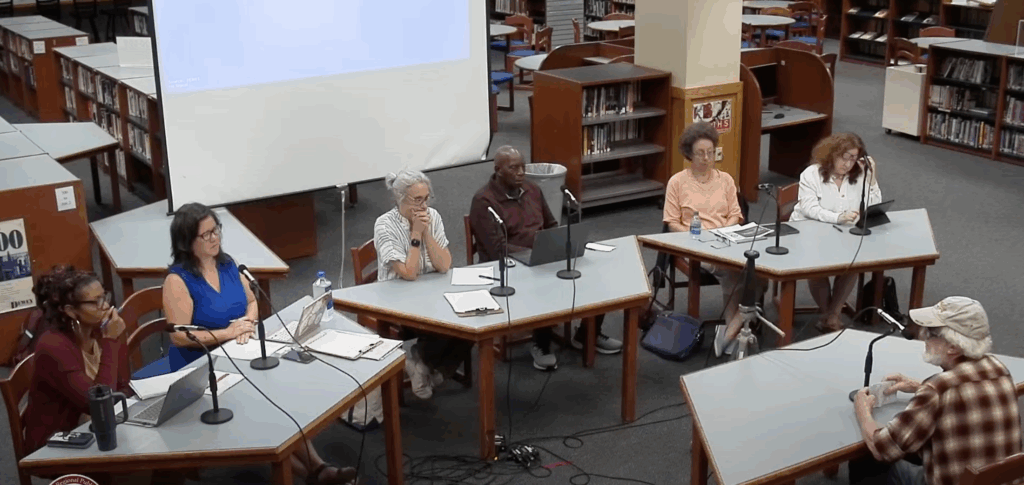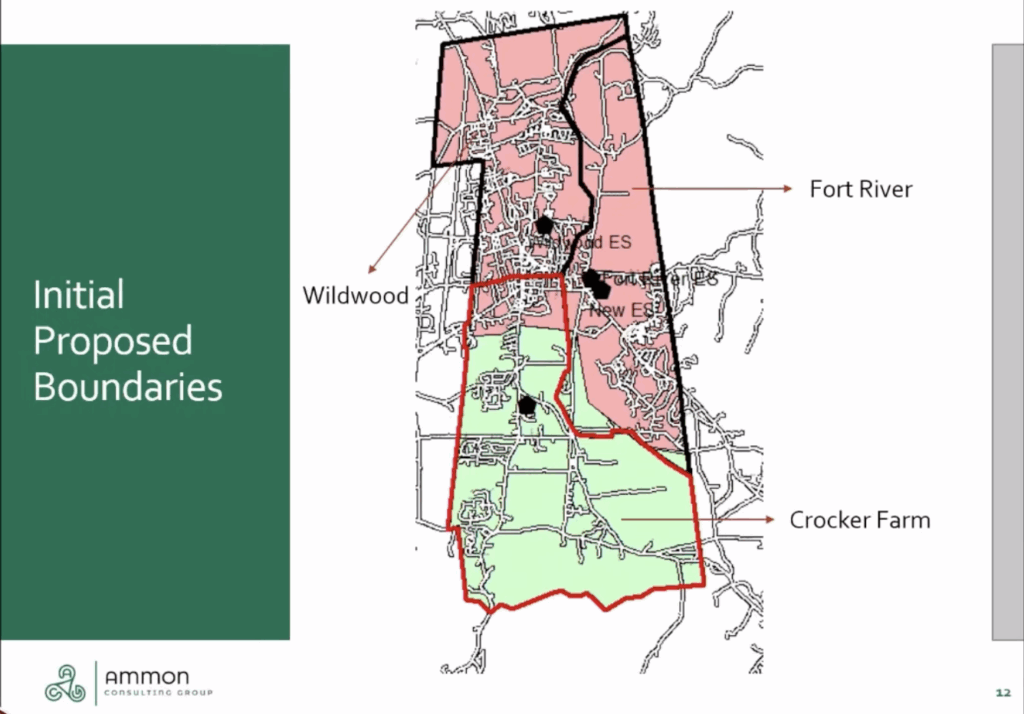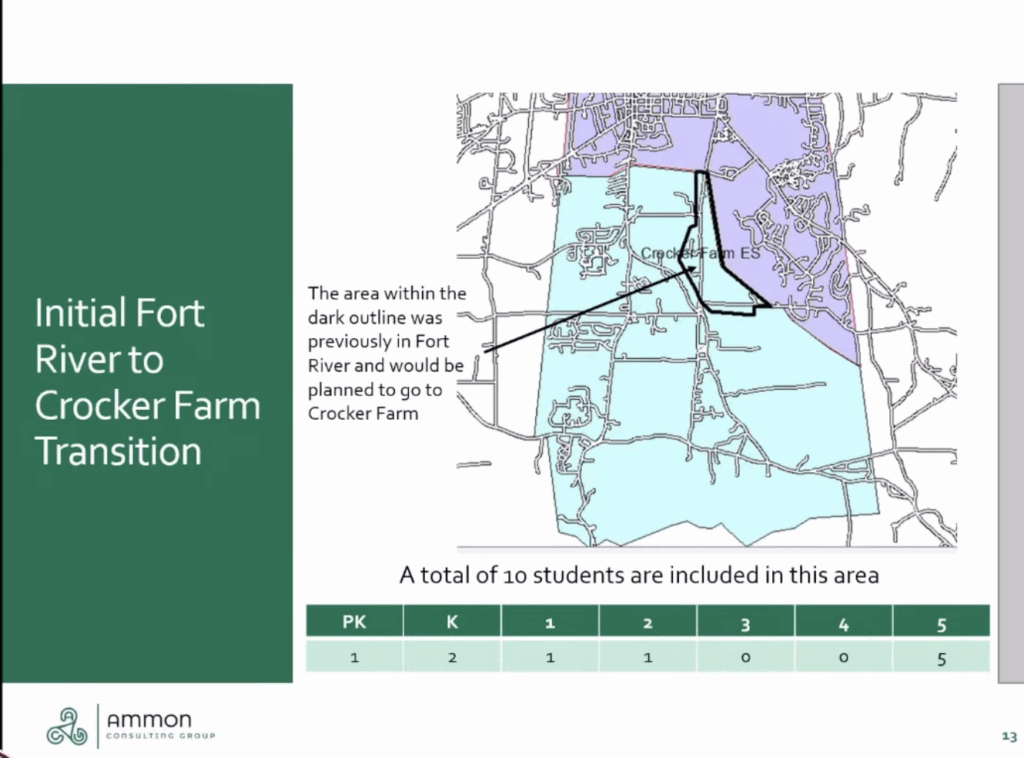School Committee Grapples with Redistricting Challenges. Superintendent Names New Principals

Vincent O'Connor offers public comment to the Amherst School Committee on September 16, 2025. Photo: YouTube/Amherst Regional Public Schools
Report on the Meeting of the Amherst School Committee, September 16, 2025
The meeting was held in the library of Amherst Regional High School, was simulcast on Amherst Media Channel 15, and was recorded.
Present
Jennifer Shiao (Chair), Bridget Hynes, Deb Leonard, Sarah Marshall, Irv Rhodes.
Staff: E. Xiomara Herman (Dr. Xi, Superintendent of Schools), Shannon Bernacchia (Finance Director), Tim Ammon (Consultant)
Overview
The bulk of the meeting was devoted to a report on the process of drawing new district boundaries for Amherst’s elementary schools. Dr. Xi announced the appointment of three new principals, and the committee welcomed the School Equity Advisory Committee (SEAC), currently active in the region’s secondary schools, to Amherst’s elementary schools.
Public Comment
Eight people offered in-person public comment. Comments focused on concerns about redistricting, about the future of the Caminantes Dual Language Program at Fort River, and on the negative impact of Caminantes on non-dual language learners.
Vanessa Gordon, the parent of a fourth-grader and a ninth-grader, raised concerns about re-districting, suggesting that as much as possible the district ought to allow kids to complete their education in the learning community in which they started. She believes that her child will be moved out of Crocker Farm to the new school and the following year to the sixth-grade academy. She asked the school committee to recognize the importance of continuity of learning communities.
Ethan Todras-Whitehall echoed Gordon’s concerns, saying that the emphasis in placement should be on continuity of experience. He said that if the schools did need to shift some students,, perhaps they could adopt a grandfather clause or school choice, giving children the option of remaining in their current learning community.
Vince O’Connor stated that the flaws in the proposal for the sixth-grade academy, which originated with the previous superintendent, became apparent early on, and he commended the current superintendent for her thoughtful approach to the proposal, which included a survey of the staff. He said, “The sixth-grade academy may be the road to perdition,” warning that many parents will take their children out of the district rather than participate in the flawed arrangement. He urged Dr. Xi to look into the actual costs of the proposal, which he deemed “isolating,” and asked her to reconsider its implementation.
Becca Watkins stated that the Caminantes program puts some students at a disadvantage. She reported that there is currently only one non-dual language section at Fort River, Explorers. This creates a situation where most of the students with special needs are concentrated in one cohort. The reputation of Explorers is that it is chaotic and disruptive. She stated that every student deserves a safe and equitable education and that is not what what is currently happening.
Angelica Bernal pleaded for expanding the Caminantes program into the secondary schools, and testified how the program had positively impacted her family.
Jeff Conant, a new Amherst resident, voiced concern that there is no collective plan in the event of an ICE raid on our schools and especially for Fort River, which houses the dual language program. He noted that while the school entrance is secure, the parking lots and grounds are not. “There ought to be emergency protocols in place to respond to such a raid while it is in process”, he said, and he requested clear communications from the district on this, clarifying protocols and expectations.
Conant also voiced concerns about too much use of screens at Fort River during lunch. He asked whether the schools have a policy around screen time at school and indicated that if not, he would like to see such a policy developed with parent input.
He further expressed concern that Caminantes may not continue after the sixth grade and as a Caminantes parent, said he would like to see that it does.
Bernadette Harrigan echoed Watkins’ comment on the negative impact of Caminantes on Explorers and implored the School Committee to investigate.
Erica (last name inaudible), the mother of a sixth-grader in Caminantes who hopes to continue the dual language program in Middle School, said that Caminantes is not simply about learning a second language but also promotes learning about identity and culture and fosters a belief that it is a good thing to be bilingual. She noted that data show that the full benefit of dual-language programs is realized only if continued through high school and advocated for continuing Caminantes at the middle school.
One public comment was received via voicemail asking whether the School Equity Advisory Committee (SEAC) would be in place in the new sixth-grade academy.
Twelve written public comments were received and can be read here.
K-6 Restructuring Update
Read Dr. Xi’s update on K-6 restructuring here and the Power Point update on enrollment projections and boundary analysis here. (Find background on the new sixth-grade academy here, and here).
Tim Ammon, of Ammon Consulting Group, provided an update on the process of drawing new district boundaries for Amherst’s elementary schools. This will be necessary to reapportion students when the new elementary school at Fort River opens in the Fall of 2026 and absorbs the students from Wildwood Elementary and Fort River Elementary. Ammon offered an example of what new maps could look like (see maps below), noting that his presentation was only a draft intended to elicit feedback from the community. He reported that, projecting out five years from 2026, enrollment is expected to remain fairly stable and that the district seeks sustainable new boundaries, that is, maps that will not require adjustment over the next five years. Several factors figure into drawing up these new maps including but not limited to demographics, diversity, transportation, and program continuity. And all of the aforementioned will be limited by the capacity of each of the two schools (currently estimated at 575 for the new school and 353 for Crocker Farm).
In the model Ammon shared, the areas of transition—that is, where students would move into a new elementary school district—have been kept to a minimum, impacting a total of 49 students, 10 currently attending Fort River, and 39 currently attending Crocker Farm. The challenge will be accommodating all of the desired outcomes. A change in one factor produces a change in the others. Prioritizing one, likely produces dramatic changes in the others. The aim is to strike a balance among all of the variables shaping the decision.




Next Steps
Ammon reported that he would be undertaking the following steps to arrive at multiple options to present to the district leadership and School Committee. He did not offer a deadline and when those options will be available.
- Continuation of discussions with principals to identify key programmatic requirements
- Demographic analysis of initial boundary considerations, including a neighborhood analysis
- Assessment of key class size determinations and evaluation of average class sizes
- Incorporation of Pre-K capacity needs into overall planning
- Finalization of boundary option(s)
Discussion
Hynes asked whether there will be room for grandparenting current students who did not want to be transitioned; that is, will the plan allow students currently attending Crocker Farm or Fort River to remain there, rather than requiring them to move?
Ammons answered yes, but emphasized that this will impact other variables and capacities at both schools.
Jennifer Shiao asked if the plans could also grandparent the siblings of students currently enrolled in a given school.
Ammon again answered yes and stressed that a change in one factor will have an impact on all the other factors determining boundaries. He said, “We will come up with a set of options that will allow us to say, if we do this, then this is what will happen.”
Irv Rhodes said he favored models that create the minimum of disruptions for families. He said he would also like to know how any proposed change will impact the cultural makeup of the schools, as children who were part of one community will now become part of another.
In response to current projections suggesting that there may be a few unused rooms at the new school, Hynes asked whether there might be enough surplus capacity at the new school to avoid adopting the sixth-grade academy next year.
Dr. Xi, responded that there would not be sufficient room to accommodate all sixth graders and at this point there is no alternative to establishing the sixth- grade academy.
Deb Leonard pointed out that the number of Amherst elementary students attending charter schools has increased by 100 students since the last redistricting. Looking at the last effort, she asked for assurance that this effort would not produce “population islands,” that is, concentrated demographic clusters in which some students are assigned to a different district than their immediate neighbors. The last redistricting produced two islands, one of them among the apartments on East Hadley road, whose residents attend both Wildwood and Fort River while living in the vicinity of Crocker Farm Leonard pointed out that islands tend to concentrate children from low-income families and asked the committee to make sure that avoiding such concentrations factors into the final maps.
Listening Sessions Coming Up
Six listening sessions are scheduled to hear concerns from caregivers and school staff concerning the transition to the sixth grade academy. There will be one session for parents on Saturday, September 27, at 10 a.m., probably on Zoom (check ARPS website for details) and five for students and staff. Dr. Xi emphasized that these sessions will prioritize hearing the concerns of the community. Shiao reminded parents who want to see the Caminantes program continue at the Middle School that these forums would be a good opportunity to share their concerns.
Instructional Hours
Committee members had questions about the instructional hours requirement at the new sixth-grade academy. While sixth-graders are still elementary school students, Massachusetts Department of Elementary and Secondary Education (DESE) requires sixth graders in a standalone setting, to meet the secondary instructional hours requirement of 990 hours per school year vs. the 900 hours required for elementary school students elsewhere. This is the standard that will be met at the new academy.
Dr. Xi clarified that district leadership has met with DESE and DESE was firm that Amherst sixth-graders at the academy would have to meet the 990-hour requirement.
Sarah Marshall questioned whether this was correct and Dr. Xi responded that the matter had been extensively studied and that she would share the documentation with the School Committee.
Leadership Update
Dr. Xi introduced three newly appointed school principals.
Juan Rodriquez will be the principal at the Middle School and for the new sixth-grade academy. The sixth grade will also have its own dedicated Assistant Principal. That person has not yet been named.
Allison Estes will be the principal at the new elementary school at Fort River.
Tamera Sullivan-Daley will be the new principal at Crocker Farm Elementary School.

Jennifer Shiao and Deb Leonard expressed surprise and concern about the appointment of Rodriguez to lead the sixth-grade academy, given the bumpy start at the Middle School this year. Shiao noted that there were multiple problems at the start of the year and that these were widely known among parents, staff, and students and have not all been resolved. She pointed out that the sixth-grade academy is an experiment and a new experience for the sixth graders and that they need a strong presence, focused on their needs. She said she does not have confidence in the proposed arrangement yet.
Dr. Xi acknowledged the bumpy start but reaffirmed her confidence in Rodriguez’s instructional leadership. She said that he deserves a fair opportunity to demonstrate what he can do, noting that he brought the Middle School into compliance with DESE instructional hour requirements within weeks, a task she estimated ought to have taken months. She asked the school committee to give him a chance to demonstrate what he can do and she is certain that things will smooth out.
Dr. Xi added, “this is a major transition for Amherst. This whole process is jarring and we should not tie this to one person. The issue is the plan: how do we comfort the community and assure them that we have created a safe and strong learning environment?”
The School Equity Advisory Committee (SEAC)
The School Equity Advisory Committee (SEAC) was created by the Regional School Committee to “help the Amherst-Pelham Regional Schools to provide all students an innovative and academically exceptional education in an environment that embraces racial, cultural, and socio-economic diversity…”
SEAC is interested in broadening its work to include the elementary schools.
The school committee voted unanimously at this meeting to support SEAC expanding to include the Amherst Elementary Schools.
Read more about SEAC here.
Next Meeting
The next meeting of the Amherst School Committee will be a joint meeting with the Regional School Committee on Tuesday, September 23, at 2:30 p.m. The meeting will be in-person in the Amherst Regional High School Library and will be simulcast on Amherst Media Channel 15.
